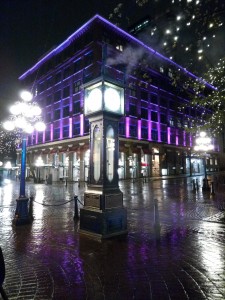What better way is there to study architecture and urban planning than to explore a new city from the perspective of a bicycle? Mobile enough to get around effi ciently and yet slow enough to take in new sights, sounds and smells. That’s what 17 students and myself had the pleasure of doing for 11 weeks in beautiful, Vancouver, British Columbia. There I was studying Kinetic Architecture and Urban Planning at Emily Carr School of Art and Design.
ciently and yet slow enough to take in new sights, sounds and smells. That’s what 17 students and myself had the pleasure of doing for 11 weeks in beautiful, Vancouver, British Columbia. There I was studying Kinetic Architecture and Urban Planning at Emily Carr School of Art and Design.
Every morning I wake up to the city noise of Davie Street below and wonder what the new day will bring. I get to bike over Burrard street to school every day where cars and bicycles begin to truly share the road in a safe fashion. My ride looks out over English bay and beyond to Stanley park. As I ride over Burrard sailboats and yachts alike make their way in and out of false creek beginning their day. First Street brings high end automobiles and a windy road until finally I reach my destination, Granville Island. A plot of land unlike any other I have been on the island abides by its own rules, set out to break traditional spaces and reinvent public space. It is clear the pedestrians of the island own the land and cars must abide by them as people stroll across the road however they please.
As I unmount and park my bike I can tell it will be a busy day. Even as the public market is just beginning to open travelers from all over the world are flooding in to take in the island and its arts and crafts in all forms. I make my way in to the hustle and bustle of the market and decide a dragon fruit will be my breakfast. I stop for a moment to observe a canvas where a picture of flowers in a field is being painted across from one of the many fruit vendors. Never co uld I have begun to imagine the diversity of such a small island in a city. The market is packed with artists that bring in their crafts for the day with the intention of selling them to the public. The stands pack in to the already busy space where artists are selling ceramic tiles with paintings, pearl earrings, custom wood work benches, chiseled marble stamps and so much more.
uld I have begun to imagine the diversity of such a small island in a city. The market is packed with artists that bring in their crafts for the day with the intention of selling them to the public. The stands pack in to the already busy space where artists are selling ceramic tiles with paintings, pearl earrings, custom wood work benches, chiseled marble stamps and so much more.
One of the woodshops is opening up their garage door for the day and I stop to look at the work strewn about the small space. Perfect wooden spheres and tear drops are scattered about the room as the artists starts his machines to continue his work. The pedestrians walking past don’t seem to faze him anymore; once he starts his work he seems entirely in tune with what is happening in front of him. As I move further towards class an asparagus painted cement truck races by exiting the concrete facility adjacent the market as another strawberry painted one enters. The silos they park under painted like caricatures. Upon first glance you imagine a children’s park hidden among the towers and trucks as the rich colors jump out at you hiding the grit of the concrete industry that lies within.
Between the gaps of the corrugated metal facades the towers of Vancouver exist behind, lying in the distance and yet only across the creek. The sea of green windows looks back at you and becomes one with  the parks the buildings extend up from. Silhouettes of bikers and pedestrians dot the rich green grass, some headed to start their days and others finding a soft patch to call theirs for the time being. A stark white sailboat’s mast splits the view as it cuts its way out of False Creek. The yellow capped logs in front of me guide me down Johnston Street and I arrive in front of Emily Carr School of Art and Design.
the parks the buildings extend up from. Silhouettes of bikers and pedestrians dot the rich green grass, some headed to start their days and others finding a soft patch to call theirs for the time being. A stark white sailboat’s mast splits the view as it cuts its way out of False Creek. The yellow capped logs in front of me guide me down Johnston Street and I arrive in front of Emily Carr School of Art and Design.
It seems so natural here that industry, academics and arts of all form come together. What better way to display the rich history that brought us Vancouver, BC in the first place. A city so young and adventurous it seems anything is possible. And as you move through Vancouver and Granville Island yourself you begin to believe anything is possible.
– Jericho Bankston, Architecture in Vancouver, Spring 2016
